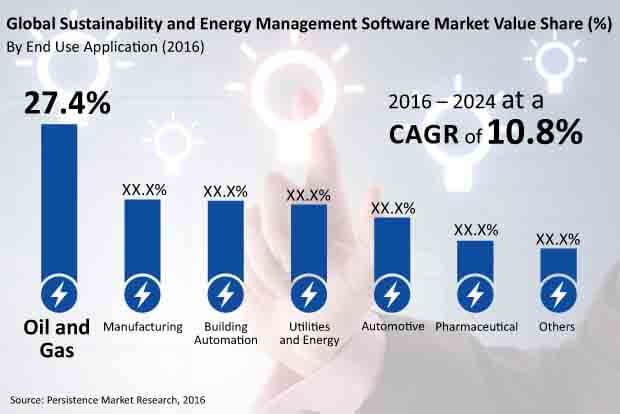Sustainability and Energy Management Software Market Segmented By Cloud Based, On Premise Software with Utility Data Management, Carbon Reporting and Management, Sustainability Reporting and Management, Energy Optimization, Facility and Asset Management, Compliance Management Module
Industry: IT and Telecommunication
Published Date: March-2017
Format: PPT*, PDF, EXCEL
Delivery Timelines: Contact Sales
Number of Pages: 181
Report ID: PMRREP9164
Sustainability and energy management software is basically a database of information that relates to the usage of energy, resources, financial data and other important factors that helps enterprises make their operations sustainable and efficient. In most cases, sustainability and energy management software solutions are used by enterprises to enhance their energy and sustainability business performance through automated data management, analysis and reporting.
These type of solutions act as a tool for project planning and management, scenario planning, portfolio management and supply chain management, which helps attain the goals of sustainability of process and energy saving. In addition to delivering value to shareholders and investors, companies today are facing close scrutiny to contribute positively to environmental and sustainability goals and achieve a greater business value. To aid this process, sustainability and energy management software is used to maximize the use of scarce resources and reduce the carbon footprint to achieve greater output in a manner that is environmentally friendly.
The global sustainability and energy management software market is estimated to be valued at nearly US$ 900 Mn in the year 2017 and is expected to touch a figure of more than US$ 1700 Mn by the end of 2024. The market is expected to register a total incremental opportunity of nearly US$ 1000 Mn between the years 2016 and 2024. The global sustainability and energy management software market is projected to register a CAGR of 10.8% during the forecast period (2016-2024).
Presently, there is an enhanced awareness regarding the concept of sustainability and energy management in companies, instead of just treating it as a regulatory obligation. This is especially true of companies operating in the manufacturing, chemicals and oil and gas sectors.
Several parameters are now coming in the ambit of sustainability management such as supply chain de-risking, operating in resource stressed areas, reliable and cost-efficient energy supplies and product stewardship initiatives, etc. Another way to look at this emerging situation is the increasing competition amongst companies and due to this intense competition, companies are looking to differentiate themselves by adopting sustainable and energy saving methodologies in their business processes, which sets them apart from competition.
In emerging economies such as India and China, small and medium enterprises are a major source of environmental pollution. As the awareness regarding protection of the environment and sustainable practices is low amongst the strata of such size of companies, they don’t take such issues seriously and there is a lax attitude. Significant investments regarding sustainable processes and pollution control are only made in large enterprises, while medium and small enterprises go off the hook.
Hence, enforcement of pollution standards is uneven and only government owned enterprises are generally subject to checks, while small scale enterprises are spared from such liabilities. It is also seen in developing economies that there is a huge variation in the process of economic planning and environmental protection goals, leading to the latter being not implemented or being poorly implemented.
As far as revenue is concerned, the building automation segment is projected to be the most attractive segment in the global sustainability and energy management software market during the projected period of this study. The building automation segment is anticipated to exhibit high year-on-year growth rates throughout the forecast period and is estimated to register a CAGR of 13.2% between the years 2016 and 2024. The oil and gas segment was valued at nearly US$ 190 Mn in 2015 and accounted for 27.2% of the global market revenue share that year.
This segment is expected to emerge dominant by the end of the year 2024, accounting for a revenue share of 28.3%. The strong growth of the building automation segment in terms of CAGR is partly due to the fact that this segment is growing from a smaller base as compared to the oil and gas and manufacturing segments, and partly due to the fact that new buildings are increasingly adopting sustainable architectural practices, mainly to reduce the emissions of greenhouse gases.

Initially, most of the enterprises were utilizing traditional sustainability reporting formats to communicate their progress, due to which they were losing the brand value associated with their social and environmental achievements. However, with growing awareness regarding brand value and reputation, along with leveraging the advantage of advanced information technologies to gain competitive advantage, enterprises are replacing these custom-built legacy systems with commercial sustainability and energy management software.”
--- Analyst – IT and Telecommunications, Persistence Market Research
|
By Software |
|
|
By End Use Application |
|
|
By Module |
|
To know more about delivery timeline for this report Contact Sales